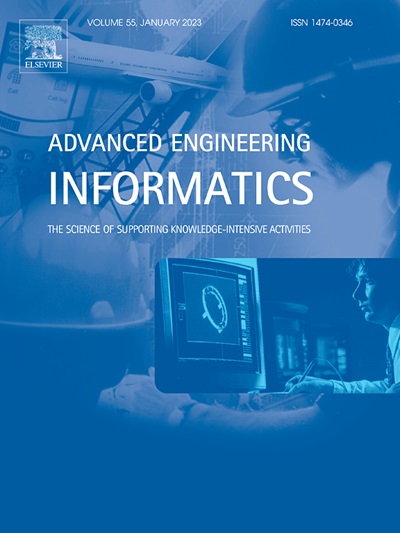基于自监督学习和自供电混合纳米传感器的智能交通异常检测系统
IF 8
1区 工程技术
Q1 COMPUTER SCIENCE, ARTIFICIAL INTELLIGENCE
引用次数: 0
摘要
交通运输是全球经济发展的基础要素,车辆异常检测在确保交通运输安全和运行效率方面起着至关重要的作用。传统的异常检测技术主要依赖于电池供电的传感器和劳动密集型的人工数据标记,从而限制了可扩展性和效率。本文介绍了一种基于时间序列的自监督框架与摩擦电磁纳米传感器(TENS)相结合的异常检测系统(ADS)。ADS通过将车辆振动转换为电能,并通过振动特征的时间重建实现自监督异常检测,代表了一种范式转变。该框架使用深度自动编码器自动生成伪标记数据集,该编码器随后训练基于lstm的分类器,而无需手动标记。实验结果表明,TENS的峰值均方根功率密度为81.97 W/m3。作为一种自供电传感器,它可以在没有外部能量输入的情况下有效地检测振动,在超过10万次的循环中保持稳定的特性,并有可能为第三方传感器供电。在涉及车辆、自动轨道交通(ART)和自行车的实证评估中,ADS的平均异常检测准确率为97.15%。与仅使用无监督重建的方法相比,ADS的准确率提高了17.81%至60.14%,也超过了基于1D-CNN的自监督方法。当部署在车辆环境中时,ADS进一步展示了强大的泛化和自监督异常检测能力。混合纳米传感器技术与先进的自我监督学习框架的无缝集成说明了可持续能源解决方案如何与尖端人工智能协同,以推进智能交通系统和预测性维护策略。本文章由计算机程序翻译,如有差异,请以英文原文为准。
An intelligent traffic anomaly detection system based on self-supervised learning and self-powered hybrid nano-sensor
Transportation is a foundational element of global economic development, with vehicle anomaly detection playing a pivotal role in ensuring safety and operational efficiency. Conventional anomaly detection techniques predominantly rely on battery-powered sensors and labor-intensive manual data labeling, thereby limiting both scalability and efficiency. This study introduces a time series-oriented self-supervised framework integrated with a triboelectric-electromagnetic nanosensor (TENS) to form an Anomaly Detection System (ADS). ADS represents a paradigm shift by converting vehicle vibrations into electrical energy and enabling self-supervised anomaly detection through the temporal reconstruction of vibrational characteristics. The proposed framework automatically generates pseudo-labeled datasets using a deep autoencoder, which subsequently trains LSTM-based classifiers without the need for manual labeling. Experimental results demonstrate that TENS achieves a peak RMS power density of 81.97 W/m3. As a self-powered sensor, it effectively detects vibrations without external energy inputs, maintains stable features over more than 100,000 cycles, and has the potential to power third-party sensors. In empirical evaluations involving vehicles, Autonomous Rail Rapid Transit (ART), and bicycles, ADS achieved an average anomaly detection accuracy of 97.15 %. Compared to methods employing only unsupervised reconstruction, ADS improved accuracy by 17.81 % to 60.14 % and also surpassed self-supervised approaches based on 1D-CNN. When deployed in vehicular contexts, ADS further demonstrated robust generalization and self-supervised anomaly detection capabilities. The seamless integration of hybrid nanosensor technology with an advanced self-supervised learning framework illustrates how sustainable energy solutions can synergize with cutting-edge artificial intelligence to advance intelligent transportation systems and predictive maintenance strategies.
求助全文
通过发布文献求助,成功后即可免费获取论文全文。
去求助
来源期刊

Advanced Engineering Informatics
工程技术-工程:综合
CiteScore
12.40
自引率
18.20%
发文量
292
审稿时长
45 days
期刊介绍:
Advanced Engineering Informatics is an international Journal that solicits research papers with an emphasis on 'knowledge' and 'engineering applications'. The Journal seeks original papers that report progress in applying methods of engineering informatics. These papers should have engineering relevance and help provide a scientific base for more reliable, spontaneous, and creative engineering decision-making. Additionally, papers should demonstrate the science of supporting knowledge-intensive engineering tasks and validate the generality, power, and scalability of new methods through rigorous evaluation, preferably both qualitatively and quantitatively. Abstracting and indexing for Advanced Engineering Informatics include Science Citation Index Expanded, Scopus and INSPEC.
 求助内容:
求助内容: 应助结果提醒方式:
应助结果提醒方式:


